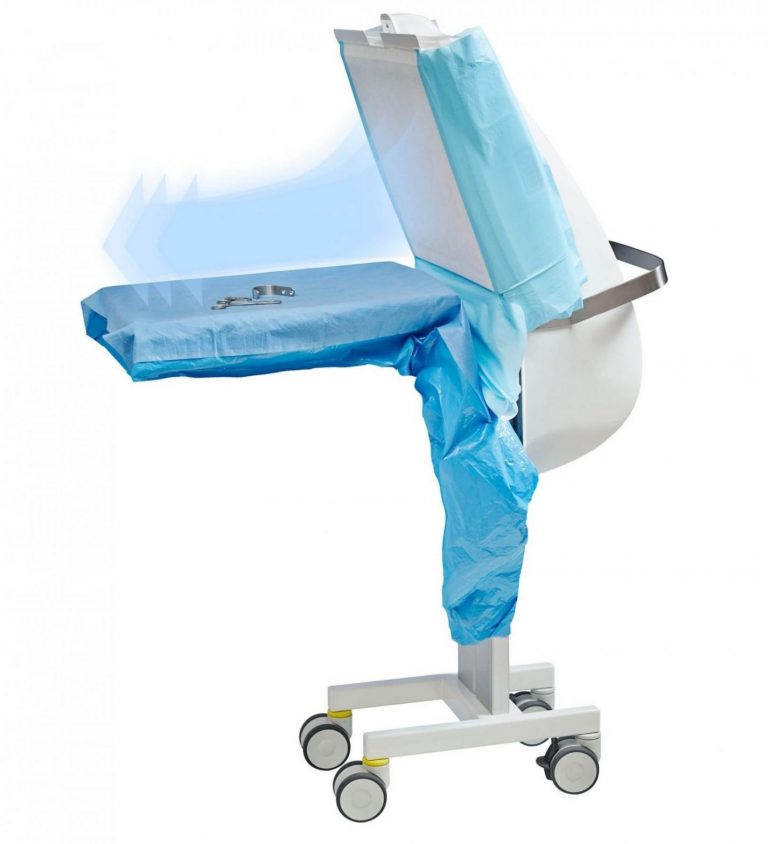Operio Laminar Air Flow: Optimized Neurosurgery Operating Room and Theatre Ventilation
Enhancing Operating Room Ventilation for Neurosurgery and Spinal Surgery
The Operio Mobile Laminar Air Flow System outperforms traditional ventilation systems in neurosurgery by delivering direct, ISO 5 sterile air to the surgical field and instruments. Unlike conventional systems, Operio’s horizontal airflow bypasses obstructions like microscopes and surgical lights, ensuring consistent sterility throughout long procedures. Its portability, cost-effectiveness, and ability to reduce infection risks make it the superior choice for maintaining aseptic conditions in complex neurosurgical environments.
Conventional operating room ventilation systems often fail to meet the sterility demands of complex procedures like neurosurgery and spinal surgery. These systems struggle to deliver ultraclean air to the operating field due to obstructions caused by operating microscopes and surgical lights. The Operio Mobile Laminar Air Flow System, combined with the Steristay, overcomes these challenges, ensuring ISO 5 conditions for both the surgical field and instruments, even during prolonged and complex surgeries.
Why Conventional Ventilation Falls Short in Neurosurgery
- Obstructions from Operating Microscopes:
- Traditional laminar airflow systems are hindered by microscopes, preventing sterile air from reaching the surgical field effectively.
- Insufficient Coverage for Instruments:
- Many conventional systems are too small to protect all instruments during surgery, increasing contamination risks.
- Crowded Operating Rooms:
- Neurosurgery often involves a large surgical team, elevating the microbial load and increasing the risk of infection.
- Longer Procedure Durations:
- Extended surgery times amplify the risk of contamination, especially in procedures involving implants, like spinal surgery.
Operio’s Solution for Advanced Surgical Sterility
- Protective Sterile Zones:
- Operio creates a sterile zone for both the instruments and operating field, ensuring ISO 5 conditions regardless of surgery duration or room occupancy.
- Infection Control Beyond Antibiotics:
- The system reduces airborne bacteria concentration to well below 10 CFU/m³, meeting the highest standards for infection-prone procedures.
- Unobstructed Sterile Airflow:
- Unlike traditional systems, Operio’s horizontal laminar airflow bypasses obstructions from microscopes and lights, ensuring direct protection of critical areas.
- Enhanced Performance in Spinal Surgery:
- With large areas of the spine exposed and implants required, spinal surgery carries a high risk of infection. Operio minimizes this risk by maintaining consistent sterility throughout the procedure.
- Cost-Effective and Mobile:
- Operio upgrades existing operating rooms without requiring expensive renovations, offering a plug-and-play solution that is portable and easy to integrate.
Combatting Surgical Site Infections (SSIs)
Maintaining strict hygiene standards during surgery is the most effective measure against surgical site infections (SSIs). However, reliance on antibiotic prophylaxis has become unsustainable due to the rise of antibiotic resistance. Studies report that 70% of bacteria causing hospital infections are resistant to at least one antibiotic agent. Operio offers a modern solution to reduce airborne bacterial contamination, helping to meet the widely accepted standard of keeping bacterial concentrations below 10 CFU/m³ in infection-prone surgeries.
“Studies Highlight Instrument Contamination Risks in Conventional Operating Rooms (ISO 7)”
Various scientific studies have demonstrated that instruments in conventional operating rooms (ISO 7), or those prepared outside the sterile air zone of a laminar air flow system (ISO 5), become contaminated within a short time. The longer the surgical procedure lasts, the greater the risk of instrument contamination, which significantly increases the likelihood of surgical site infections (SSIs).
A 2013 study by Thomas Benen, Frank Wille, and Lüder Clausdorff in Hygiene & Medizin (2013; 38-4) underscores this issue, showing that ventilation systems play a critical role in maintaining microbiological instrument cleanliness. Conventional systems often fail to prevent contamination, emphasizing the need for advanced solutions like Operio Mobile Laminar Air Flow, which ensures ISO 5 conditions and protects instruments throughout the duration of surgery. https://www.researchgate.net/publication/286283458_Influence_of_different_ventilations_systems_upon_the_contamination_of_medical_devices
“Karolinska Hospital Case Study: Mobile Laminar Flow Units in Neurosurgery”
The Karolinska Hospital case study demonstrates how mobile laminar flow units (MLAF) significantly reduce colony-forming units (CFU) during neurosurgery, achieving ultra-clean air levels in the operating room. This study highlights the critical role of MLAF in enhancing sterility compared to conventional ventilation systems.
Significant Results:
-
- Comparing MLAF-equipped operating theatres with those using conventional ventilation showed substantial reductions in CFU levels near the surgical site and on the instrument table.
- These results underscore the effectiveness of mobile laminar flow in maintaining ISO 5-level sterility.
Get in Touch with Normeditec
We’re here to help you enhance your surgical solutions with the Operio Mobile Laminar Air Flow Unit. Contact us for expert advice, product information, or assistance.
Contact Information
Email: info@normeditec.com
Phone:
- Germany: +49 7139 2090859
- Italy: +39 348 730 24 45
WhatsApp Support:
- Germany: +49 176 62 13 16 34
- Italy: +39 348 730 24 45
Languages Spoken: English, German, French, Italian
Website: www.normeditec.com
We deliver worldwide and are available via video call for support and guidance. Let’s make advanced aseptic solutions accessible to your practice today!
Benefits:
up to 95% more “sterility” for the operating area and instruments
upgrade of existing operating rooms quickly and cost-effectively
mobile-no installation work required
eliminates bacteria and micro-organisms (including coronavirus covid 19) by over 99.9%
Related products

Operio portable laminar air flow
The Operio Mobile Laminar Air Flow Unit provides ISO 5 sterile conditions, transforming conventional operating rooms and outpatient surgical spaces into ultra-clean environments. Its focused sterile airflow protects the surgical field and instruments, ensuring maximum sterility for eye surgeries, ENT procedures, day surgeries, cardiology, all types of implant surgeries, plastic and aesthetic surgeries, orthopedic operations, and more. Ideal for enhancing infection control and surgical precision across diverse medical disciplines.
Go to product
Steristay instrument table with hepa filter
TOUL Steristay– Focused laminar flow with built-in backtable is ideal to keep the surgical instruments sterile. While implants are opened only at the last moment to ensure sterility, the instruments used for implantation remain exposed on traditional instrument tables. This exposure significantly increases the risk of contamination and surgical site infections.
Go to product
 it
it en
en fr
fr de
de











